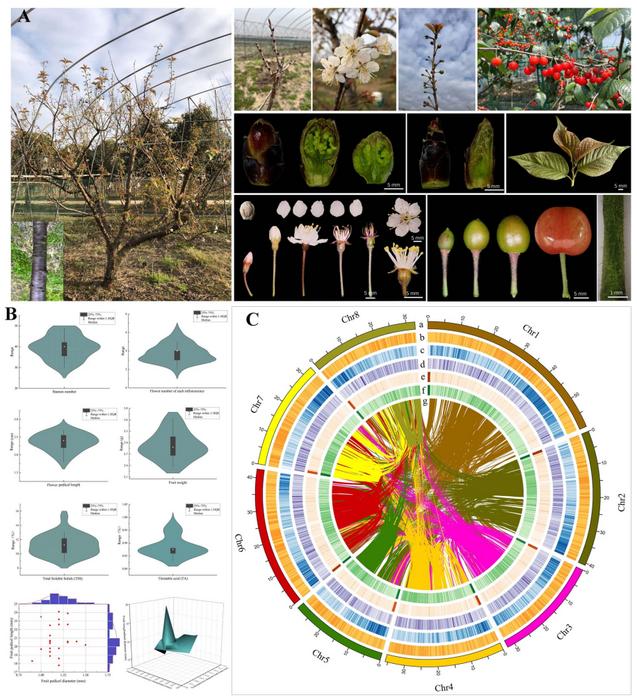A significant milestone in horticultural genomics has been reached with the successful decoding of the tetraploid Chinese cherry genome. This study provides essential insights into the genetic factors that influence fruit firmness, a critical trait for enhancing the cherry’s market appeal and transportation durability. By unraveling the genetic intricacies of Prunus pseudocerasus, the research paves the way for targeted breeding strategies that could improve fruit quality and expand the commercial potential of this economically important crop.
Chinese cherry (Prunus pseudocerasus) is highly valued for its economic and nutritional benefits, yet its soft fruit texture poses a challenge for marketability. Traditional breeding approaches have struggled to enhance this trait due to the species’ complex tetraploid genome and high genetic heterozygosity. With fruit firmness being a key quality factor, understanding its genetic basis has become a priority for breeders. These challenges highlight the need for in-depth research into the genetic mechanisms that govern fruit firmness in Chinese cherry.
A research team from Shanghai Jiao Tong University has successfully assembled the first chromosome-level, haplotype-resolved genome of the Chinese cherry cultivar ‘Zhuji Duanbing,’ as published (DOI: 10.1093/hr/uhae142) in Horticulture Research on July 8, 2024. Using advanced sequencing technologies like PacBio HiFi, Oxford Nanopore, and Hi-C, the study decoded the highly heterozygous genome of this tetraploid species. The findings provide crucial insights into the genetic determinants of fruit firmness, offering a valuable resource for breeding programs aimed at improving the commercial traits of Chinese cherry.
The study tackled the challenges posed by the tetraploid nature of the Chinese cherry genome, achieving a high-quality genome assembly through the use of state-of-the-art sequencing technologies. By comparing the soft-fleshed ‘Zhuji Duanbing’ with the firmer ‘Heizhenzhu’ sweet cherry, the research highlighted the critical role of pectin, cellulose, and hemicellulose in determining fruit texture. The softer texture of ‘Zhuji Duanbing’ was linked to accelerated cell wall degradation during ripening, particularly within the pectin matrix. Two genes, GalAK-like and Stv1, were identified as key regulators of this process, showing significant expression differences between the two varieties. These genes, involved in pectin biosynthesis and modification, are promising targets for future genetic improvements. The study deepens our understanding of the molecular mechanisms behind fruit firmness in Chinese cherry, providing a foundation for selective breeding aimed at enhancing this important trait.
Dr. Caixi Zhang, a lead researcher, highlighted the significance of this genomic achievement: “The assembly of a haplotype-resolved genome for Chinese cherry is a major advancement in horticultural genomics. Identifying the genetic factors that influence fruit firmness allows us to adopt targeted breeding strategies, essential for increasing the commercial appeal of Chinese cherry. This research not only enriches our knowledge of cherry genetics but also offers a critical tool for breeders aiming to develop firmer, more marketable varieties.”
The findings from this study have significant implications for the future of Chinese cherry cultivation. By utilizing the newly identified genetic markers for fruit firmness, breeders can develop cultivars with enhanced texture, suitable for long-distance transport and global distribution. This research lays the foundation for precision breeding in Chinese cherry, potentially boosting the crop’s commercial value and ensuring its competitiveness in both domestic and international markets. The techniques and insights from this study can also be applied to other fruit crops, aiding in the genetic improvement of firmness and other quality traits.
A significant milestone in horticultural genomics has been reached with the successful decoding of the tetraploid Chinese cherry genome. This study provides essential insights into the genetic factors that influence fruit firmness, a critical trait for enhancing the cherry’s market appeal and transportation durability. By unraveling the genetic intricacies of Prunus pseudocerasus, the research paves the way for targeted breeding strategies that could improve fruit quality and expand the commercial potential of this economically important crop.
Chinese cherry (Prunus pseudocerasus) is highly valued for its economic and nutritional benefits, yet its soft fruit texture poses a challenge for marketability. Traditional breeding approaches have struggled to enhance this trait due to the species’ complex tetraploid genome and high genetic heterozygosity. With fruit firmness being a key quality factor, understanding its genetic basis has become a priority for breeders. These challenges highlight the need for in-depth research into the genetic mechanisms that govern fruit firmness in Chinese cherry.
A research team from Shanghai Jiao Tong University has successfully assembled the first chromosome-level, haplotype-resolved genome of the Chinese cherry cultivar ‘Zhuji Duanbing,’ as published (DOI: 10.1093/hr/uhae142) in Horticulture Research on July 8, 2024. Using advanced sequencing technologies like PacBio HiFi, Oxford Nanopore, and Hi-C, the study decoded the highly heterozygous genome of this tetraploid species. The findings provide crucial insights into the genetic determinants of fruit firmness, offering a valuable resource for breeding programs aimed at improving the commercial traits of Chinese cherry.
The study tackled the challenges posed by the tetraploid nature of the Chinese cherry genome, achieving a high-quality genome assembly through the use of state-of-the-art sequencing technologies. By comparing the soft-fleshed ‘Zhuji Duanbing’ with the firmer ‘Heizhenzhu’ sweet cherry, the research highlighted the critical role of pectin, cellulose, and hemicellulose in determining fruit texture. The softer texture of ‘Zhuji Duanbing’ was linked to accelerated cell wall degradation during ripening, particularly within the pectin matrix. Two genes, GalAK-like and Stv1, were identified as key regulators of this process, showing significant expression differences between the two varieties. These genes, involved in pectin biosynthesis and modification, are promising targets for future genetic improvements. The study deepens our understanding of the molecular mechanisms behind fruit firmness in Chinese cherry, providing a foundation for selective breeding aimed at enhancing this important trait.
Dr. Caixi Zhang, a lead researcher, highlighted the significance of this genomic achievement: “The assembly of a haplotype-resolved genome for Chinese cherry is a major advancement in horticultural genomics. Identifying the genetic factors that influence fruit firmness allows us to adopt targeted breeding strategies, essential for increasing the commercial appeal of Chinese cherry. This research not only enriches our knowledge of cherry genetics but also offers a critical tool for breeders aiming to develop firmer, more marketable varieties.”
The findings from this study have significant implications for the future of Chinese cherry cultivation. By utilizing the newly identified genetic markers for fruit firmness, breeders can develop cultivars with enhanced texture, suitable for long-distance transport and global distribution. This research lays the foundation for precision breeding in Chinese cherry, potentially boosting the crop’s commercial value and ensuring its competitiveness in both domestic and international markets. The techniques and insights from this study can also be applied to other fruit crops, aiding in the genetic improvement of firmness and other quality traits.
###
References
DOI
10.1093/hr/uhae142
Original Source URL
https://doi.org/10.1093/hr/uhae142
Funding information
This work was funded by the China Agriculture Research System (Grant No. CARS-30-2-08), and the Natural Science Foundation of Shanghai (23ZR1430600).
About Horticulture Research
Horticulture Research is an open access journal of Nanjing Agricultural University and ranked number one in the Horticulture category of the Journal Citation Reports ™ from Clarivate, 2023. The journal is committed to publishing original research articles, reviews, perspectives, comments, correspondence articles and letters to the editor related to all major horticultural plants and disciplines, including biotechnology, breeding, cellular and molecular biology, evolution, genetics, inter-species interactions, physiology, and the origination and domestication of crops.
Journal
Horticulture Research
DOI
10.1093/hr/uhae142
Subject of Research
Not applicable
Article Title
Haplotype-resolved genome assembly for tetraploid Chinese cherry (Prunus pseudocerasus) offers insights into fruit firmness
Article Publication Date
8-Jul-2024
COI Statement
The authors declare that they have no competing interests.





